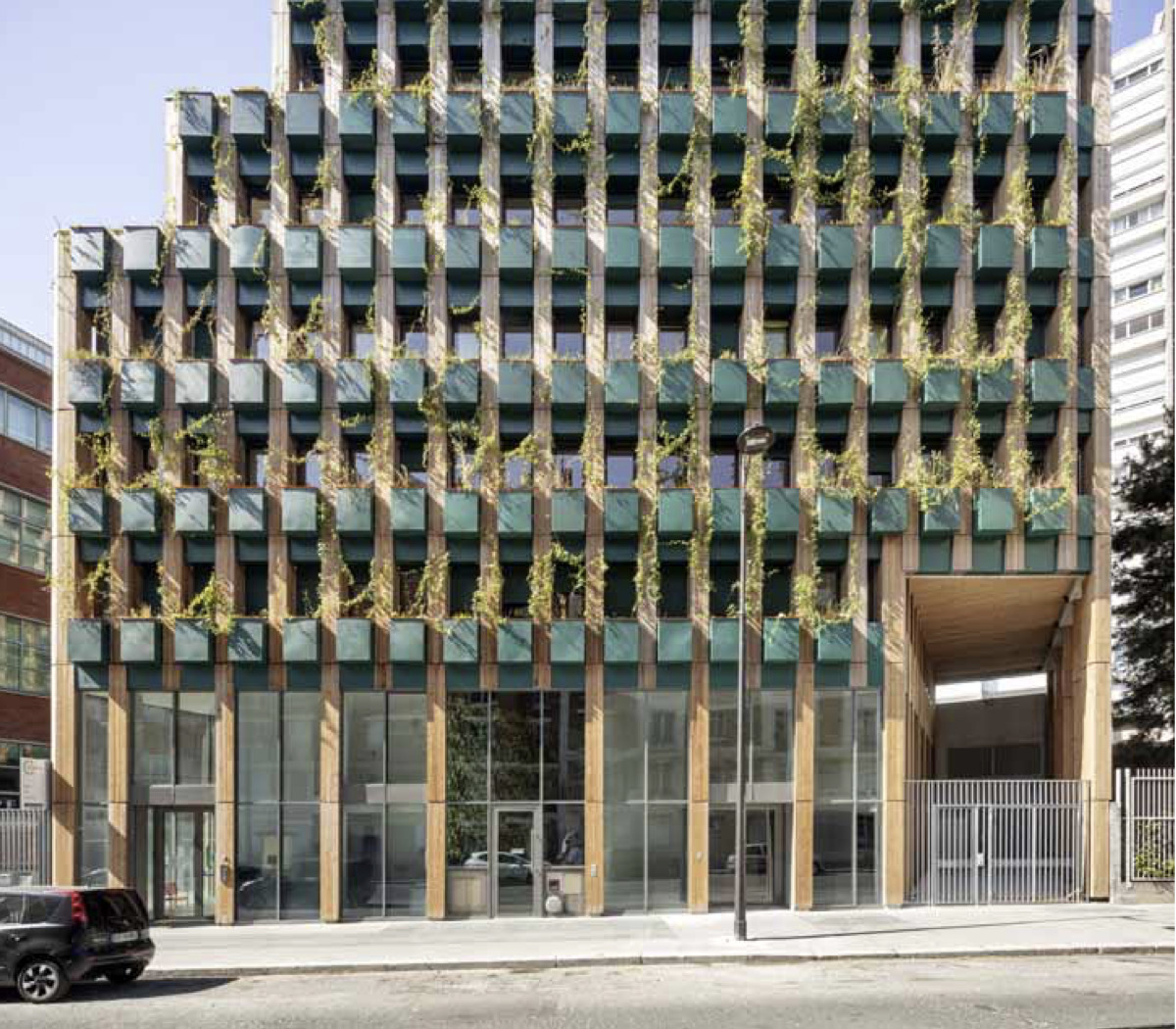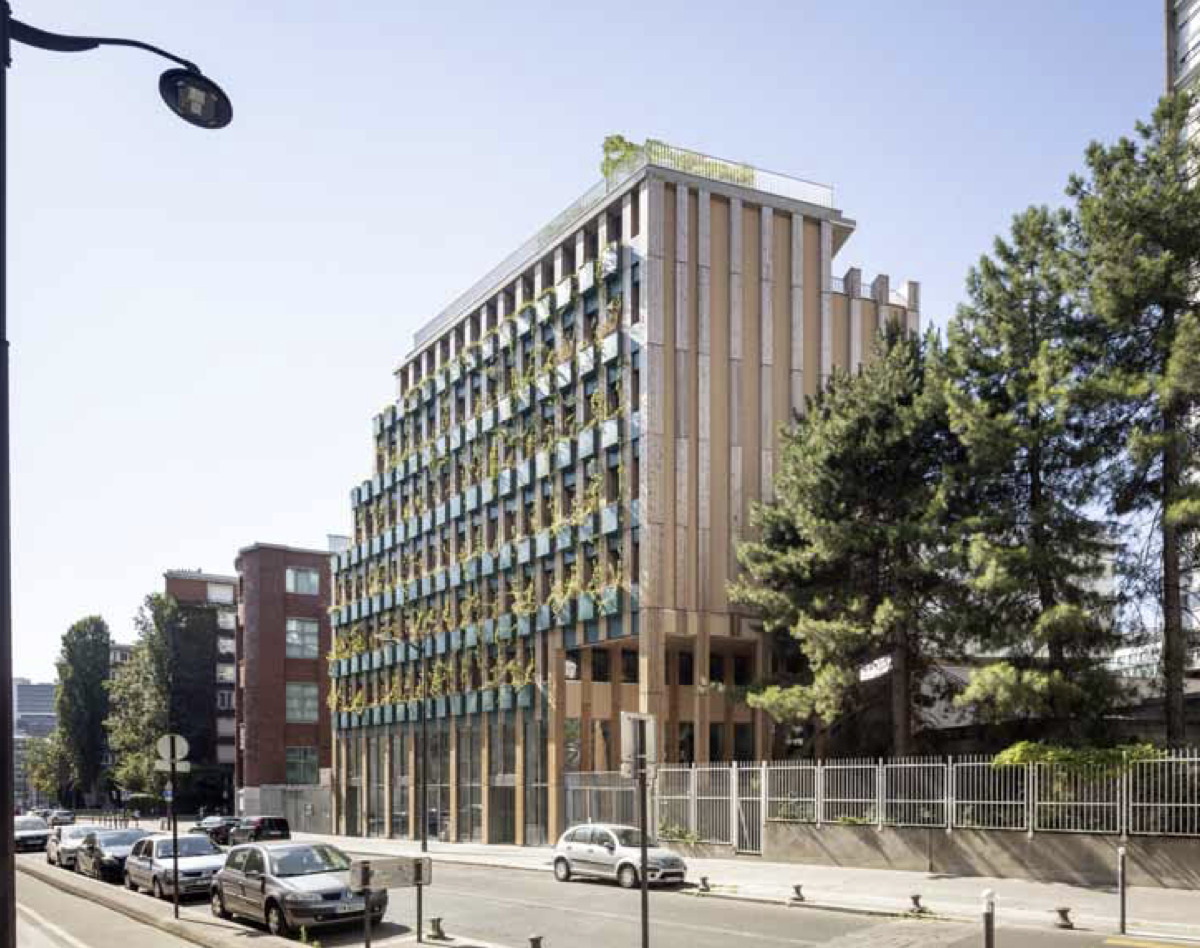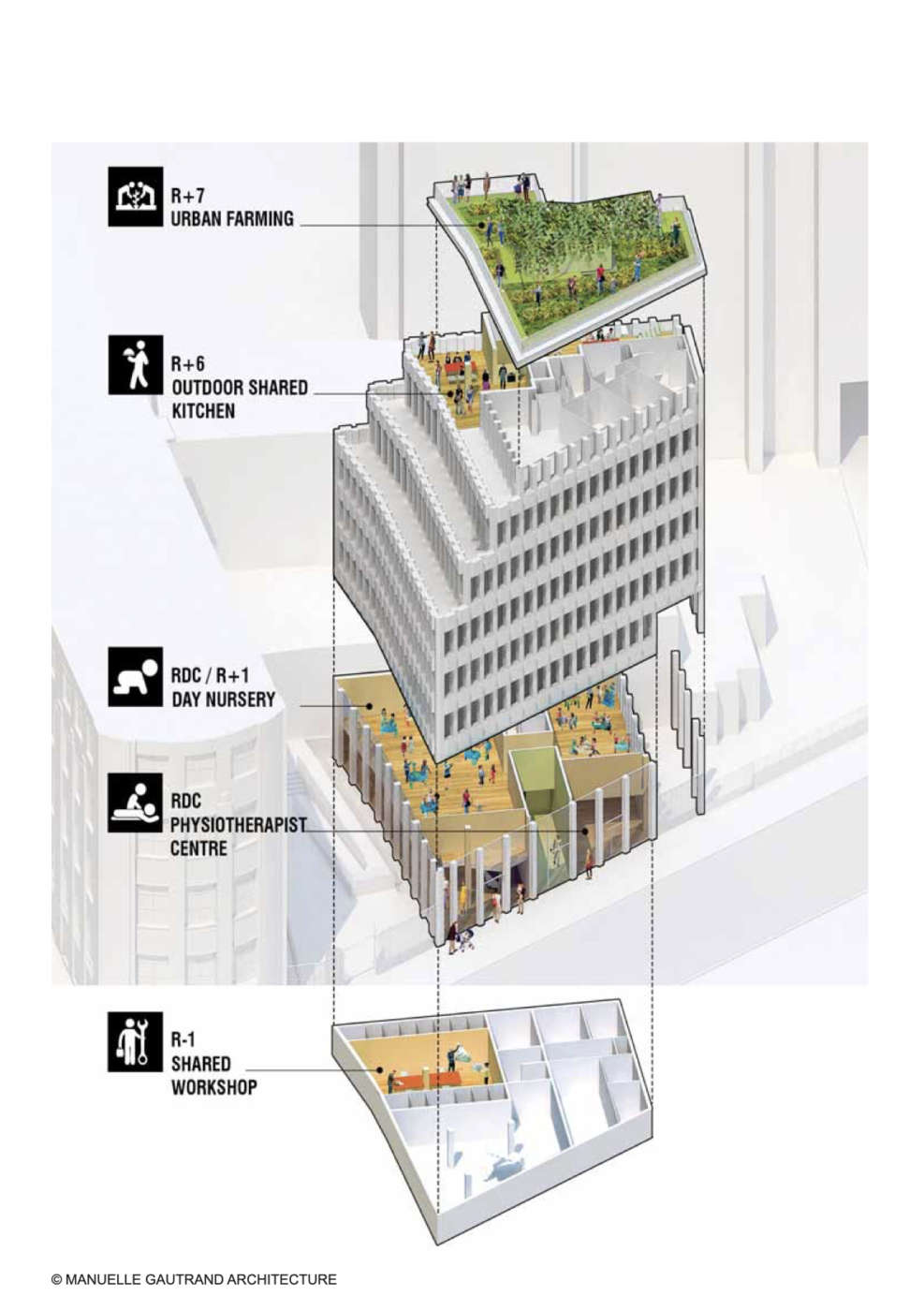Among the 22 architectural projects selected from the call for innovative urban projects launched by the City of Paris, ‘REINVENTER PARIS 1’, Edison Lite project proposed a new housing model, based on three main principles that we established: the creation of ‘made-to-measure’ housing units, whereby the future residents were able to participate in establishing the brief as well as the design of their home; the provision of 20% extra surface area, defined and shared with the residents: this provides access to space and facilities that would not otherwise be available to individual residents; to welcome residents into an existing landscape: largely planted during works, the architectural project includes 75 mc of soil, divided between 290 planters and a large, 150 mq allotment on the roof.

These plants have had time to establish themselves and grow before the arrival of residents. Residents are thereby greeted by an established natural environment, for which they will have responsibility. The project thus proposes a sort of ‘permacultural’ way of life: residents will produce some of their own food, learning the pleasure of watching food grow, a means of encouraging them to participate in the collective effort that we must all undertake to reduce supply chains and move towards a landscape of edible permaculture as near as possible to home. With regards materials, the project set itself the principle of ‘the right material in the right place’. The result is an optimised combination of concrete, timber and metal.

It should be noted that the apartments are sold at a fixed price of 7,990 euro incl. VAT per square metre, around 30% lower than the market rate. All sales and marketing was conducted online thanks to online platform HABX: nearly 2,000 applications were received for the 13 open-market units. The buyers were selected according to a variety of criteria aimed at ensuring a community of residents both diverse and compatible. The building includes two fitted-out commercial units on the ground floor: one is now occupied by the Babilou crèche and the other is a physiotherapy practice.

A CRAMPED SITE IN PARIS’ 13TH DISTRICT
The site is right next to the Place d’Italie in the 13th arron- dissement of south-east Paris, a tiny residual space of 415 mq abutting the site of the Maurice Ravel school of music. This tiny plot is entirely enclosed in the midst of extre- mely varied urban fabric, both in terms of architectural treatment as well as of the imposing height of the built masses that dominate it. Thus dominated by these constructions and enclosed by the site’s restrictive perimeter, we designed a project that aims to outmanoeuvre these constraints. We quickly became aware that this site is representa- tive of the challenges of tomorrow’s cities, where densi- fication has to be approached very carefully, developing good manners with regards the different buildings in close proximity. Rather than dismissal, the occasional densification of certain sites must rather bring a kind of renewal and reat- tribution; here, in this existing site of only a few hundred square metres, the construction of a new project must add value and literally embellish it.
MORE THAN 20% OF SPACE SHARED BY RESIDENTS
The second major innovation is the construction of more than 20% of communal space programmed and shared by the residents. These communal spaces were designed as a route, accompanying the residents and providing them with meeting places from the basement level right up to the roof. This provides them with areas and functions that they would not individually have been able to create. It must be noted that these ‘extra’ functions occupy a privileged position within the building, that which would usually be reserved for the best, and therefore most expensive, apartments on the upper floors. We thereby made the choice to assign the project’s best spaces - those with the best views and most sunlight - for all the residents to share. A large part of the added value of this project thereby comes from its capacity to create a unique atmosphere, inviting each resident to use these shared spaces, to feel at home and spend a lot of time there.
- In the lower section of this route, at level -1, is a large workshop for residents’ use, close to their basement storage; on the ground floor is a secure bicycle storage area, accessed from the large shared entrance hall.
- On level 6 is a huge area comprising a south-facing sun deck and a west-facing open-air communal barbecue kitchen facility.
- Above, on level 7, is the 150 mq allotment, which crowns the project with 360-degree views.
These shared amenities shape the project, infusing it with real community spirit; they really constitute the binding agent in the project, weighing in the decision to come and live here rather than somewhere else. They crystallise the residents’ aspirations, an expression of a kind of stimulating generosity, of flexibility and fluidity, able to provide that which an apartment building cannot usually provide: it offers something of what’s found in a house with its own garden, but without the inconvenience of being far from central Paris. These spaces will contribute to the formation and narrative of the new model of housing that we all dream of.
CLOSE TO NATURE 290 LARGE PLANTERS ACROSS THE FACADE
Abundant planting in the communal spaces continues into the private spaces, constituting another major undertaking of the project. Situated on a narrow plot surrounded by buildings, some imposing, we designed facades that were both largely glazed but also largely planted, in order to create a kind of filter to mask direct views. Thus 290 large planters punctuate the windows of the facade, with an average of 14 planters per unit, which, along with the shared allotment, equates to 10 mq of soil per apartment. The planters have been planted with 310 passionflower plants, which ‘belong’ to the collective, along with 4,320 bulbs and 1,418 rushes (Luzula) in the residents’ private planters. More than 6,000 plants were thereby planted before the residents’ arrival, ensuring the established planted landscape that we see today. Our objective was to create a continuum between residents and nature: no window is bare, each is equipped with a planter in front, dressing the view, framing the landscape and projecting the resident into a planted foreground. The apartments become components of a larger ensemble, integrating residents in an expanse of nature, which envelops both facades and roof. The architecture of the project is rooted in soil, earth, water, plants: coming right into the foreground, this vegetation creates the repository for the apartments and families that live in them. Thus, every family has the impression of living within the landscape that we designed, and which was already there. Each family has the responsibility of looking after it, ensuring that it flourishes and spreads across the facade and over the roof, to live in harmony with it. In the end, the Edison Lite project gave us as much work in forming a happy and responsible community of residents as in creating this varied and enveloping natural world around the construction. In the spirit of community, where communal and private spaces interweave and interlink, planting is designed both for private and communal areas. Thus, each planter has two large passionflowers at either end, which were planted before the residents moved in, which will be looked after by the building’s community; this principle makes it possible to establish planting before the arrival of the residents. Other plants have also been established in each planter, a sort of gardening starter kit for residents. While some residents may not naturally have green fingers, they will be gradually encouraged, the established planting allowing them to take their time and build up the desire for more. On top of this, each planter is equipped with an automatic watering system, guaranteeing a basic level of moisture all year round and paid for by the building. Everything is therefore in place for residents and nature to install themselves in harmony, forming a continuum of life.
THE ALLOTMENT ROOF
The project replies to the objectives set by the City of Paris in 2001: to become a new landscape of urban agriculture, with the emergence of new urban–rural exchange. The City’s aim is to reach 100 hectares of planted walls and roofs, of which 33 hectares of urban agriculture; this aim is detailed in the ‘100 hectares’ charter published in 2016. On the small scale of our project, whose footprint is only 387 mq, no less than 148 mq of this is covered in soil, i.e. nearly 40%. The 150 mq allotment is thereby divided up so that each resident has their own plot, in which they can plan and plant a vegetable patch. The residents were given a tutorial in order to encourage them, teaching them about growing edible products; the aim is consistent throughout our project, to inspire the residents to want to share their home with nature, to build up a close relationship with it, to nurture it so it will then nurture them.
‘MADE-TO-MEASURE’ HOUSING CO-DESIGNED WITH THE FUTURE RESIDENTS
Edison Lite is first and foremost a building of ‘made-to- measure’ housing, that is to say co-designed with its future residents. Residents were selected from a great number of applications, organised and managed by the HABX platform. Once the residents had been selected, we worked with them initially to orientate them in choosing the position of their unit within the building, and then to guide them in the interior fit-out of their apartment. The residents present a range of family situations, all different: we took care that on each floor the various families would have things in common but also complementarities: a real alchemy was sought to create, step by step, a solid community of residents.
THE RIGHT MATERIALS IN THE RIGHT PLACE
The structural principle of the project is based on a combination of materials, concrete, timber, metal. In the facade, timber is the predominant material (53%). The building is organised around a concrete core (stairwell, lift cage and landings) and a series of concrete posts on the facade, freeing the floor plates from any intermediary structural elements. Between the facade posts (at every 1.2 m) the spandrel panels are timber framed and alternatively in concrete to take the loads. All the external windows (including the French windows onto terraces) are in stained solid pine. In the facade, the posts are used to distribute the watering and drainage systems for the automatic watering of the project’s 290 planters. The posts are covered in thermally modified timber.
The technical concept is based on the following 3 principles:
a) To combine several materials while respecting the mechanical characteristics of each. The principle is to use the right material in the right place, avoiding having to over-size certain elements and the consequent increase in cost of the structure.
b) Maximum use of prefabrication for speed of installation and minimised waste on site.
c) Obtaining flexibility of internal spaces by means of a load-bearing structure spanning as much as possible onto the central core and the facades.
The load-bearing structure was designed so as to create open floor plates on the same principle as office spaces. It is composed of a concrete core, a column-and-beam structure and a curtain-wall facade in natural timber. The core makes it possible to group the stairs and lift, as well as ensuring much of the stability, as do the facades. The limited number of columns are incorporated into the party walls or partitions of the apartments.
A ‘PERMACULTURAL’ WAY OF LIFE
The Edison Lite project attempts to invent a new kind of density: a density mixing nature and Man, where nature is established before the residents move in. Its pre- existence imposes a respect, establishing it as a resident of an existing ecosystem, within which residents must take their place with humility. On its minute scale within the City of Paris, the project aims for a kind of ‘permacultural’ way of life: residents will produce some of their own food, learning the pleasure of watching food grow, whether in the allotments or the planters. A means of familiarising them with a certain resilience, of encouraging them to participate in the collective effort that we must all undertake to reduce supply chains and move towards a landscape of edible permaculture as close as possible to home. The project also shows a desire to supplement private space with areas, whatever their use, that engage residents in sharing: in the practice we develop all of our projects by questioning the brief we have received. How can we give more to the residents who are going to live or work here? How can we open up the most private unit to communal areas to be shared, between residents, and then between residents and the city itself? How can we create a harmonious progression from private to public, ensuring that no plot is entirely private, but that it invites the population to enter and share some of the amenities of the brief?

Project Sheets
Project: Edison Lite, winner project of the innovative call for projects ‘ 2016 Paris Re-invented ’.
Location: 71 Avenue Edison, 75013 Paris
Programme: Apartment building containing 21 units: 13 units for the open market, 6 controlled rental units, 2 social housing rental units, with a crèche and a retail unit on the ground floor.
Client: SCCP EDISON LITE (Loftissime + NFU / HABX)
Design Team: MANUELLE GAUTRAND ARCHITECTURE: Architects BUREAU BAS SMETS: Landscaper S2T: M&E and Structural Engineers VPEAS: Quantity Surveyor
Main Contractors: GTM BÂTIMENT: General contractor + HVAC - plumbing + electricity + cladding + external joinery KETANCHE (sub-contracted): Roof - waterproofing TRACER (sub-contracted): Planters YSOFA (sub-contracted): Curtain wall + frame
Surface area: Total floor area: 2,067 mq, of which 1,539 mq housing and 528 mq commercial. 385 mq of Shared and programmed areas: Urban farming: 150 mq, workshop: 69 mq, solarium and outdoor common kitchen: 78 mq, multi-purpose room: 47 mq bicycle storage: 41 mq
Construction cost: 4 300 000 euro HT
Dates: Competition: 2015, Design phase: 2016-2017 Construction phase: 2018-2019 Completion: 2020



























